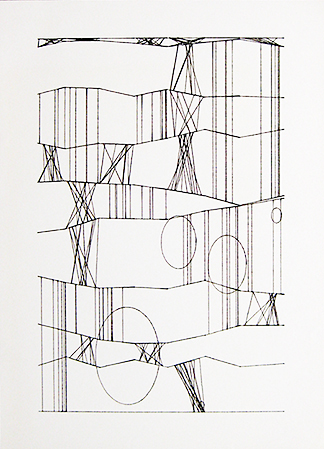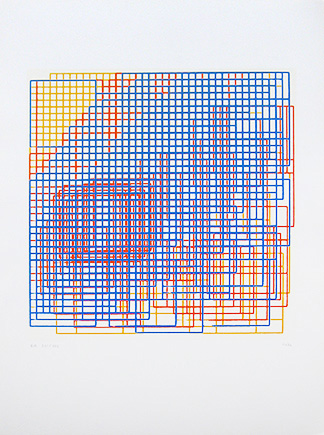Pioneer Work: Frieder Nake
In the 1960s Frieder Nake (*1938) studied mathematics in Stuttgart, Germany, and became part of the experimental circle around Max Bense,
who had formed the theoretical fundament for early computer art with his information aesthetics.
Frieder Nake held his first exhibition together with Georg Nees in November 1965 at the Wendelin Niedlich Gallery, Stuttgart.
Check out The Blog for a textile artwork by Nake!
Pioneer Work #1 25/2/65 No.14 (Rectangular Random Polygon)
The motif of this early machine drawing »25/2/65« was generated on 25th of February 1965 as No. 14 in a series of motifs.
Both motifs were used for editions using different colors in the edition of No. 13 and also different line thicknesses for the edition of No. 14.

|

|
Frieder Nake:
25/2/65 No. 14 (Rectangular Random Polygon)
machine drawing, 31 x 22,5 cm
Edition: 150
According to Nake s program the ER56 produced an edition of unique plots: every drawing in this edition is different.
generated: 1965
main frame: ER56 - Standard Elektrik Lorenz
drawing machine: Zuse-Graphomat 64
|

Pioneer Work #2 Hommage à Paul Klee
»Hommage à Paul Klee« is probably Nake s most prominent work.
Inspired by Paul Klee s painting »High Roads and Byroads«
(Museum Ludwig, Cologne, Germany, see Wikipedia),
Nake wrote an image program with COMPART ER56 for the mainframe Standard Elektrik Lorenz ER56.
The drawings were made by the ZUSE-Graphomat Z64.
More on »Hommage à Paul Klee« on the V&A website and
in the compart database at dada.compart-bremen.de
A variation of »Hommage à Paul Klee« is next:

|

|
Frieder Nake:
Hommage à Paul Klee (Variation)
plotter drawing: ZUSE Graphomat Z 64, 1966
black ink on white paper, 28 x 20 cm
edition: 100
numbered and signed on reverse side
generated: 1965/1966
|

Pioneer Work #3 Walk-Through-Raster
There are several variations of
the motif »Walk-Through-Raster« taken from Nake s software programed in 1966.

|

|
Frieder Nake: Walk-Through-Raster -
from the portfolio »Art ex machina«
silk screen print, 1972
motif generated on IBM 360/65, with Fortran IV
|

Artist's Profile
Frieder Nake
Born in Stuttgart, Germany, 1938, studied mathematics in Stuttgart. First experimental works with a mainframe in 1963, influenced by
Max Bense. 1967 Ph.D. doctoral thesis on stochastic equation systems.
Nake is a pioneer of computer art, his works were displayed in many exhibitions, e.g. at the
Cybernetic Serendipity exhibition in London, 1968.
Since 2005 Frieder Nake is a professor at the »Digital Media« section of the art college (Hochschule für Künste) in Bremen, Germany. Lives in Bremen.
Many of Nake s »pioneer works« have been on display in major computer art exhibitions, e.g. in:
»Cybernetic Serendipity« London, 1968.
»Venice Biennale«, Venice, Italy, 1970
»Ex Machina - Frühe Computergrafik bis 1979« Kunsthalle Bremen, 2007
»bit international« ZKM Karlsruhe, 2008-2009
»Die präzisen Vergnügen« Kunsthalle Bremen, 2004-2005 and ZKM Karlsruhe, Germany, 2005
»Programmierte Kunst. Frühe Computergraphik.« Kunsthalle Bremen, Germany, 2018
»Chance and Control: Art in the Age of Computers« Victoria and Albert Museum, London, GB, 2018
and e.g. publicized in:
Ästhetik als Informationsverarbeitung. Frieder Nake (1974)
Computer-Grafik Galerie. Herbert W. Franke (1984)
Ex Machina - Frühe Computergrafik bis 1979. Hrsg. Wulf Herzogenrath und Barbara Nierhoff-Wielk (2007)
A Little-Known Story about a Movement, a Magazine and the Computer's Arrival in Art: New Tendencies and Bit International. Hrsg. Margit Rosen (2011)
Computergraphik - Computerkunst. Herbert W. Franke (1985)

|
|




